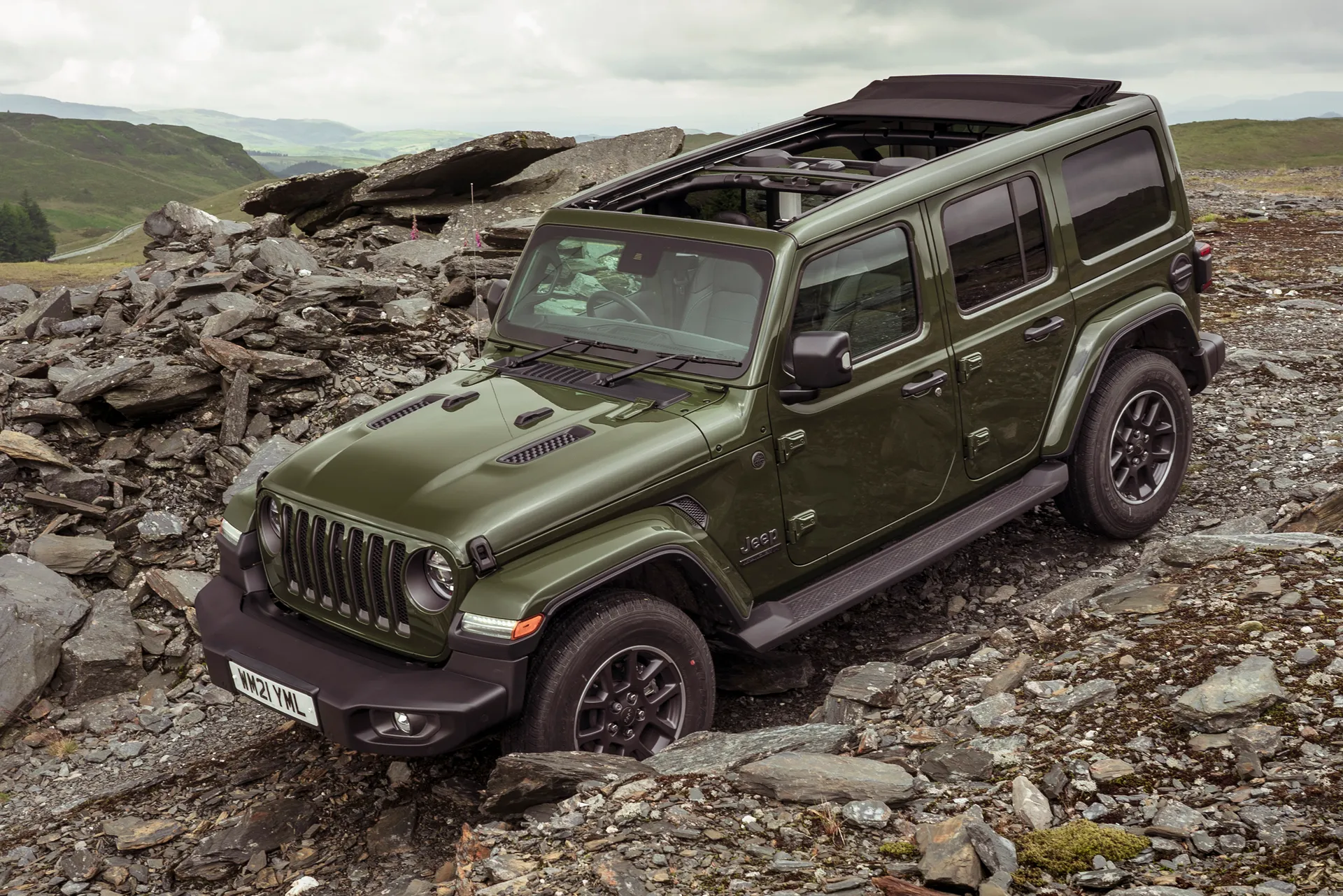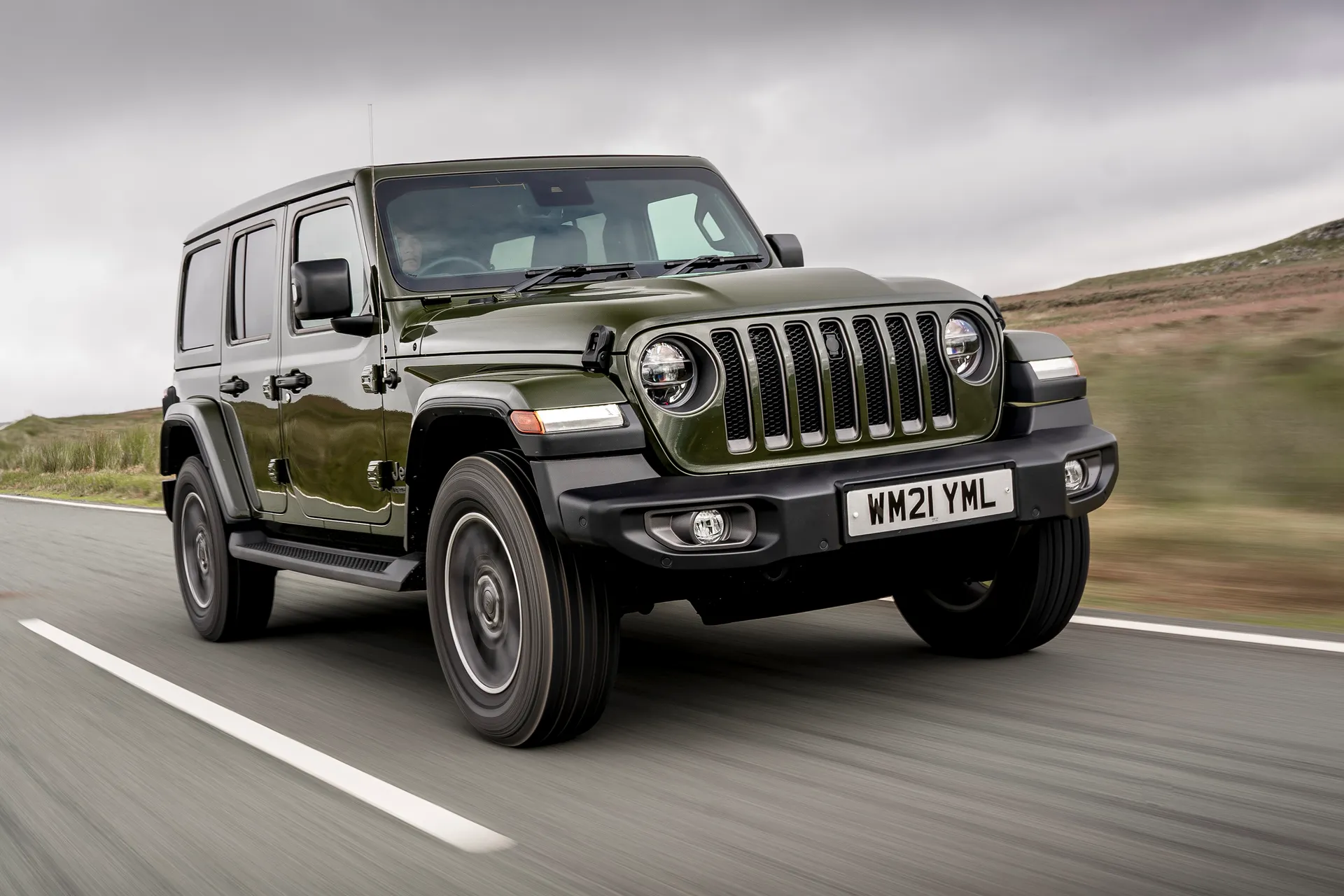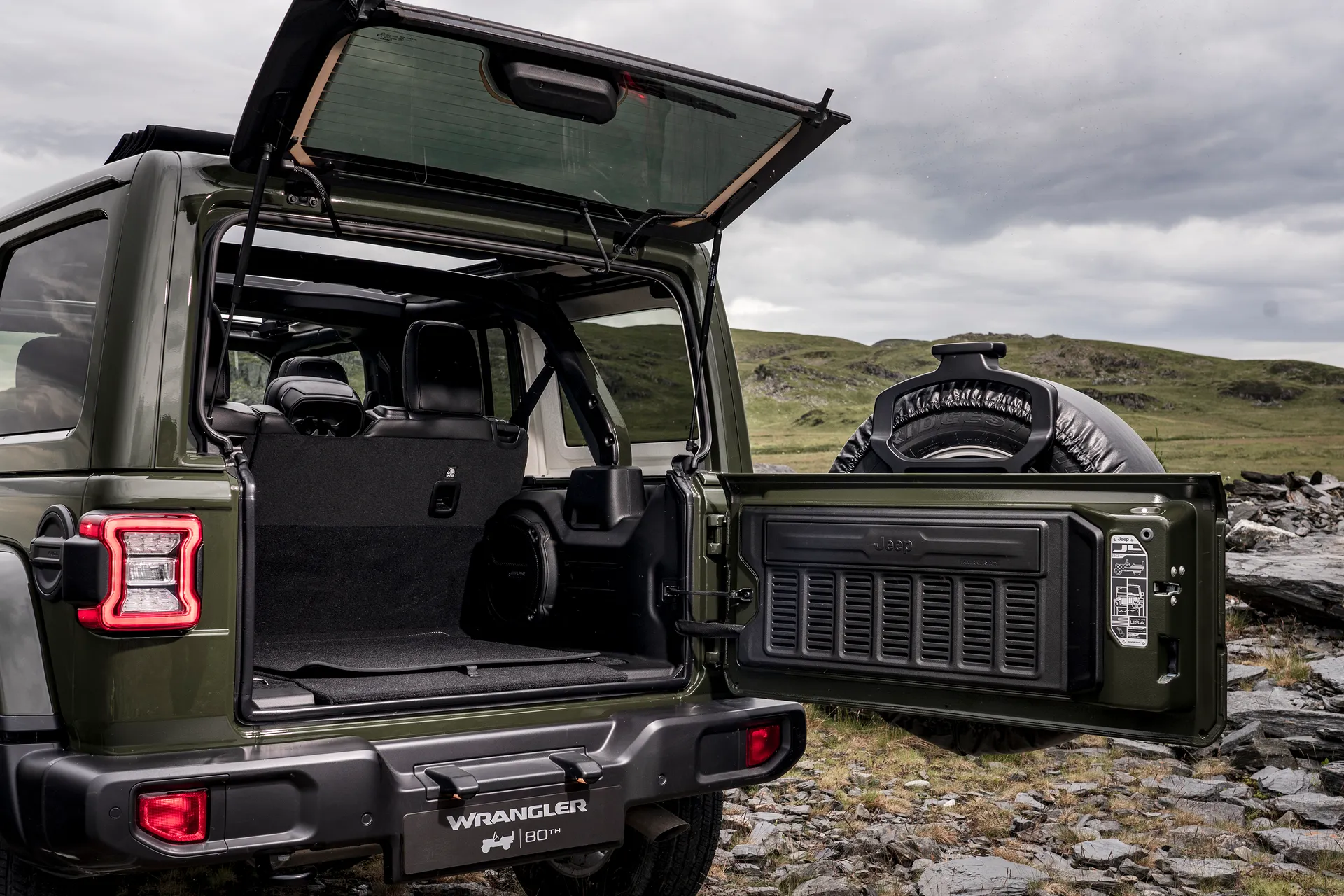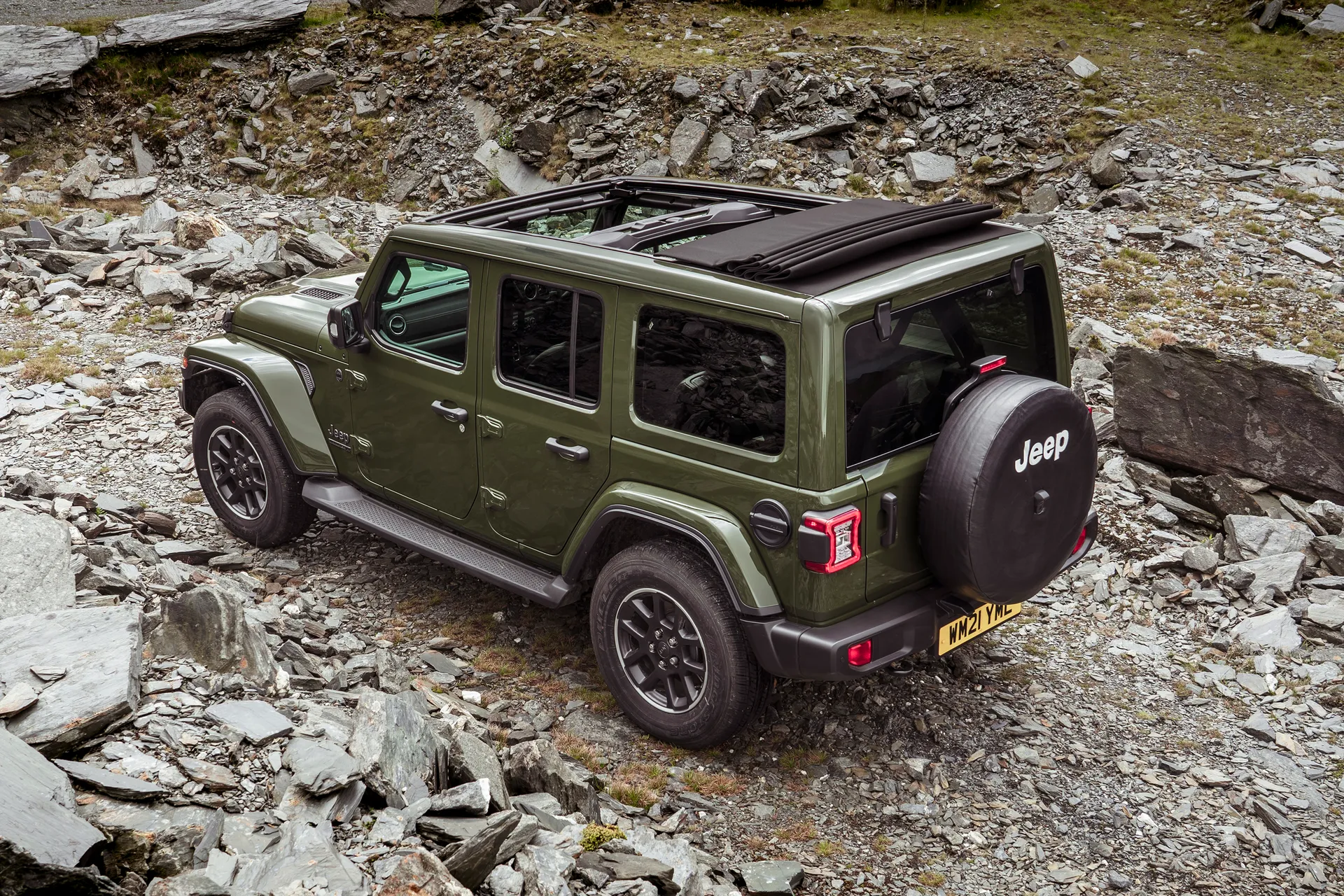Jeep Wrangler Review 2025: Price, specs & boot space
Written by Andrew Brady
Quick overview
Pros
- Looks cool inside and out
- Impressive acceleration
- Pretty much unstoppable off-road
Cons
- Pretty uncomfortable and cumbersome on-road
- Lots of road noise
- Relatively expensive to buy and run
Verdict: Is the Jeep Wrangler a good car?
"The Wrangler story started way back in the 1940s with the birth of the original Willys Jeep. This was a rugged utility vehicle that took the American military over inhospitable lands in all four corners of the globe, made all the more inhospitable by the fact that they were probably having some sort of war with the natives of the area at the time."

Yes, things have changed since the 40s but, as you'll read in this Jeep Wrangler review, the character and the ethos remain. The iconic upright shape has clear links, and rather than following the crowd of newer SUVs and watering down the ruggedness in pursuit of luxury and sophistication, the Wrangler is still a no-nonsense, rufty-tufty, weapons-grade off-roader. This thing will go places that owners of regular SUVs would fear to even think about, let alone tread.
It also has a few party-pieces up its sleeve that are inherited from its ancestor. Each version has a roof that’s removable in some way (a variety of different options are available on that score, from a folding fabric soft-top to a removable hard-top), and if you really want to open yourself up to the elements, you can also remove both the windscreen and the doors if you so wish - try doing that on an Audi Q5. You’ve also got a spare wheel bolted onto the side-hinged tailgate. No crummy pot of sealant here. The woefully impractical two-door has been dropped, too, leaving the four door.
It should be said that the Wrangler's focus on ruggedness means it’s not a civilised car, especially compared to regular SUVs at the same (rather lofty) price point. The ride is jittery, the handling’s untidy, the cabin is noisy and the interior is more functional than flashy. So, if you’re an average SUV buyer who’s merely looking for a stylish family car, pretty much anything else on the market will probably suit you better: those looking for a left-field SUV choice will be biting off way more than they can chew with the Jeep.
That which the Wrangler does, though, it does very well indeed, and it’s no accident that this car has legions of dedicated fans the world over.
Looking for a used car for sale? We've got 100s of Jeep Approved Used Cars for Sale for you to choose from, including a wide range of Jeep Wrangler models for sale.
Is the Jeep Wrangler right for you?
If you’re the sort of person who spends your weekends belting along green lanes and winching yourself up mountains, rather than nipping down to Starbucks and getting your nails done, then the Wrangler could well be for you. If you’re not that dedicated to the off-roading cause, however, then it very probably isn’t.
There aren’t many cars of any price that can do what the Wrangler can do off-road. It’s packing all manner of mud-plugging hardware that allows it to venture along terrain and up slopes that many people wouldn’t think possible in a car. What’s more, it also looks really cool and is dripping with charm and heritage.
However, this ability in the rough stuff means it's very compromised on the road in terms of comfort, handling and refinement. It’ll also cost you more to buy and run than many rivals, and it won’t give you as much practicality or kit. It’s safety record is also woeful. Those after a left-field family car need not apply. Those after an off-roading icon really should, though.
What's the best Jeep Wrangler model/engine to choose?
Choosing an engine is easy as there's only one now. However, we'd recommend the entry-level Sahara as it's packed with tech, unless you plan to ford the Rubicon river. Still, the price difference isn't massive between the two trim levels.
What other cars are similar to the Jeep Wrangler?
Over the years, the Wrangler has only had one real rival, another car derived from ancient military field transport: the Land Rover Defender. Otherwise, genuine hardcore off-roader rivals are hard to find.
The now cancelled Suzuki Jimny was much smaller and much cheaper while the Mercedes-Benz G-Class is much more expensive. However, if you’re simply after an SUV rather than an off-roader, there are countless choices, the Audi Q5 and Volkswagen Tiguan, to name but two.
There's also the similarly-priced Toyota Land Cruiser.
Comfort and design: Jeep Wrangler interior
"The Wrangler’s interior design is unsurprisingly utilitarian. You sit right up close to the pretty-much-vertical windscreen, behind a chunky, upright dashboard, with the door shutting right up against your right-hand side and the bottom of the centre console intruding into the left-hand side of your footwell. At first, it all feels very novel, like you’re in an old movie about the Vietnam war, keeping tabs on a VC stronghold with an M16 slung over your shoulder. Before long, though, you realise that you’re actually in Surrey, and you’re more cramped, and ultimately less comfortable, than in a conventional SUV."

That said, the seats are very supportive, and all versions feature a powered driver's seat with a decent range of movement.
You get a good view out over the long bonnet, and the design of the wheel arches helps you see where the extremities are at the front quarters of the car. The big, square windows all round give you a decent view out of the back, and all versions come with reversing sensors and a rear-view camera in case you need more help.
Engine revs and speed are displayed on easy-to-read dials with further driver information on a configurable digital display in between. The centre touchscreen is within easy reach and surrounded by a rugged rubberised frame. Below that sits a console that’s absolutely covered in buttons and switches. Most of them are suitably big, chunky and easy to hit, but the sheer number of them can be a bit bamboozling.
Quality and finish
If you’ve had a Wrangler before, you’ll be impressed by the quality on show in the latest one, because it’s a distinct improvement on what’s gone before. While most SUVs have soft, squishy interior surfaces, most of the Wrangler’s are hard and robust, but that completely suits the nature of the car.
Indeed, the interior is designed so you can wipe it clean and hose it out, although if you look closer, there are several nooks and crannies in the floor where mud could be very hard to get at. Most importantly, though, everything feels solid and substantial, giving the impression that this car will last a lifetime. Also, there are stitched leather wrappings for the steering wheel, transmission shifters and door pulls to help inject a bit of classiness.
Similarly, the windscreen uses a layered composition with an inner panel of Gorilla Glass, making it 52% thicker.
Infotainment: Touchscreen, USB, sat-nav and stereo in the Jeep Wrangler
Both trim levels get an 12.3-inch touchscreen with navigation, upgraded sound and Apple Carplay/Android Auto. What's more, the screen is responsive, the graphics are fast and sharp and the menus are reasonably easy to find your way around. A 7-inch TFT gauge cluster, a 9-speaker Alpine audio system, a rear backup camera, and front and rear parking sensors are standard.
All versions also get a digital display between the instrument dials to deliver key information. The display can be configured in a wide variety of ways, and pretty much whatever you do, it’s easy to understand and the graphics are clear.
Space and practicality: Jeep Wrangler boot space
The Wrangler was available in two very different forms, the two-door and the much longer four-door. And what you picked drastically altered the car's performance. Now, only the four-door exists.
There are three rear seats instead of two, and they’re surrounded by a lot more space, allowing adults to travel in some semblance of comfort.
The boot is slightly smaller at 533 litres vs the old car's 598, but you can still take plenty of kit with you on your adventures into the wilderness. The rear bench, meanwhile, folds down in two portions, giving you more versatility when you need to carry big loads. Dropping the rear seats increases the boot to 2050 litres.
The side-hinged tailgate makes the space a little bit awkward to get to when you’re in a tight parking space, and you have to flip up the rear window separately.
Both trims are 1894mm wide and 4882m long. The Sahara is 1838mm tall while the Rubicon is 10mm taller.
Handling and ride quality: What is the Jeep Wrangler like to drive?
"There’s a big difference between an SUV and an off-roader, and the Jeep Wrangler is definitely the latter."

It can go places that owners of most SUVs wouldn’t even dream of attempting thanks to its four-wheel drive, low-range gears and selection of other off-roading hardware. It’s also partly thanks to soft suspension that allows a lot of wheel movement, and if you select the ultra-hardcore Rubicon model, you also get the Rock-Trac Full Time 4:1 4x4 system. This is a more versatile system designed for tough off-roading, as the name suggests.
On the road, meanwhile, it can deal with potholes better than most normal cars and you certainly won’t have to think twice about mounting a kerb. However, the Wrangler’s level of off-road excellence inevitably means some compromises in on-road sophistication. Sure enough, the car jitters and judders its way along the road the whole time, regardless of whether the surface beneath you is messy or immaculate. Just as unsettling is the way that the body bounces around untidily on undulating roads.
You can’t really criticise the Wrangler too much for its shortage of handling precision, given the sort of car it is, but you can’t ignore the fact that the steering is very slow and overly light, while the sloppy body control means you’ll find yourself slowing down for bends much more than you would in a more conventional SUV.
Having said all that, though, it’s still true that the latest Wrangler is appreciably less compromised on the road than previous versions, so that’s something.
What engines and gearboxes are available in the Jeep Wrangler?
Before, buyers could pick from petrol or diesel. The 2.2-litre 200 PS diesel was the most popular, delivering reasonably brisk performance in most situations, and its generous low-down muscle not only made it flexible, but it also helped when you’re wading through the sticky stuff.
Next was the petrol is a turbocharged 2.0-litre four-cylinder petrol engine delivering 272PS, the only engine that's offered with new cars now.
Like the previous diesel, the petrol's mated to an eight-speed automatic gearbox driving all four wheels. It shifts up and down the ratios smoothly and cleanly, although it could react quicker when you ask it for a sudden burst of acceleration.
Refinement and noise levels
The diesel suited the Wrangler's rough-and-tumble persona. But not to worry, because the petrol is considerably quieter and smoother, but somehow it doesn’t feel quite as appropriate in a car like this.
Otherwise, the blunt shape of the front end means you hear a fair amount of noise from the wind rushing over the top of the windscreen, and it catches the large door mirrors as well. The wide tyres kick up a fair amount of road noise, too.
Safety equipment: How safe is the Jeep Wrangler?
There aren’t many cars these days that don’t manage to achieve the full five stars in Euro NCAP crash tests, so for the latest Wrangler to score just one is a fairly spectacular failure. And, if you read the detailed report, it looks like it was pretty lucky to get that.
While most modern cars offer six or more airbags dotted around the cabin, the Wrangler gets just four, and all of those are up front. So, those in the back have to rely on little more than their seatbelt and crossed fingers for crash safety.
Standard safety tech includes parking sensors, a backup camera, forward collision warning, blind spot detection, side curtain airbags, lane departure warning and traffic sign detection.
MPG and fuel costs: What does a Jeep Wrangler cost to run?
"The diesel engine was financially sensible as it returned 37 mpg, but the petrol returns 25 mpg."

It's not great, but perhaps Jeep will reintroduce the diesel unit at some point. Still, the Toyota Land Cruiser isn't miles off the petrol's figure at 26.4 mpg. Opt for a Land Rover Defender V8, and this dropped to a worrying 18.8 mpg.
Jeep Wrangler reliability
Jeep Wranglers sell in such small numbers in the UK it's hard to to get an accurate sense of the car's reliability, although we have heard reports that older cars suffer from leaks around the rear footwells, and have various electrical issues.
That said, a three-year warranty comes as standard with all models and it's still too early to tell if these issues were rectified in newer models.
Jeep Wrangler insurance groups and costs
Older cars lie between insurance groups 32 and 41, but the new trim levels start slightly higher. Oddly, the entry-level Sahara is more expensive to insure at group 41 than the Rubicon, which sits in group 40. Group 40 and 41 cars include the Land Rover Defender and Discovery.
VED car tax: What is the annual road tax on a Jeep Wrangler?
The latest Wrangler was launched in 2018, after the Government decided to change the VED tax laws to apply a flat rate of £150 to petrol and diesel cars, and to apply a five-year surcharge of £325 to cars that cost over £40,000 when new.
As of 1 April 2025, there's an updated flat rate of £195. Sadly, both the Rubicon and Sahara emit massive C02 figures - 250g/kg and 269g/kg, respectively. Be prepared to pay between £2,340 and £2,745 for first-year 'showroom tax'. After the first year, this drops to the standard rate.
Jeep Wrangler price
"At the time of writing, prices for brand new Wranglers start at just over £60,000. Compared like-for-like, prices seem very similar to those of the car’s only real rival, the Land Rover Defender, while other proper hardcore off-roaders are way off on price."

There’s a colossal difference in terms of resale values, though. The Wrangler’s are terrible compared to the Land Rover’s, and while that could prove expensive for buyers of new versions, it means used car buyers will pick up a Wrangler for way less than a Defender.
New-gen 2.2 diesel Wranglers are priced from £26,000. Brand new ex-demonstrator cars start from £53,000, meaning a circa £8,000 saving when compared to buying new.
Trim levels and standard equipment
Before, there were four trims available - Sport, Sahara, Overland and Rubicon. Sport and Overland have since been dropped leaving Sahara and Rubicon.
The entry-level Sahara offers stacks of equipment to boot such as 18-in alloys, side steps, LED headlights, a 3-piece hard top, heated front seats and steering wheel, dual zone climate control, keyless entry, and sat-nav.
Upgrading to Rubicon spec adds electronic sway bar disconnect, Nappa vinyl seats, acoustic front carpets, and 17-inch alloys.
Ask the heycar experts: common questions
Are Jeep Wranglers good off-road?
Is the Jeep Wrangler a good daily driver?
Where is the Jeep Wrangler made?
Get our latest advice, news and offers
Keep me updated by email with the latest advice, news and offers from heycar.
By submitting you agree to our privacy policy



